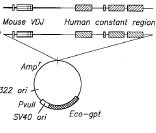 MedImmune v. Genentech (Supreme Court 2006).
MedImmune v. Genentech (Supreme Court 2006).
Earlier this year, the Supreme Court granted MedImmune’s petition for certiorari to determine when a patent licensee can challenge the validity of a patent. The CAFC has held on a number of occasions that a licensee in good standing has no standing to sue for declaratory judgment because it is not under threat of being sued for patent infringement. However, this conclusion pushes against the Supreme Court’s 1969 decision in Lear v. Adkins which held that a public policy interest in invalidating bad patents was strong enough to warrant a limitations on a licensee’s ability to give up its right to challenge a patent’s validity.
The specific question presented is as follows:
Does Article III’s grant of jurisdiction of "all Cases . . . arising under . . . the Laws of the United States," implemented in the "actual controversy" requirement of the Declaratory Judgment Act, 28 U.S.C. § 2201(a), require a patent licensee to refuse to pay royalties and commit material breach of the license agreement before suing to declare the patent invalid, unenforceable or not infringed?
MedImmune’s brief and the first batch of amicus briefs have been filed and are reviewed below.
MedImmune’s Argument is quite simple — neither the Declaratory Judgment Act nor the Constitution exclude patent licensees from the scope of DJ jurisdiction, and such a per se rule is wrong because there are situations where an actual case or controversy exists between the licensee and licensor. The linchpin of MedImmune’s case is their argument that “apprehension of suit is not a necessary condition [of establishing a concrete legal controversy], and this Court has never suggested such a thing.”
U.S. Government filed its brief and presents a number of interesting arguments. Specifically, the SG argues that the CAFC “has erected an unwarranted obstacle to declaratory relief in patent cases” that “cannot be justified by considerations of patent policy.”
[The CAFC’s] limitation on the availability of declaratory relief cannot be squared with this Court’s cases or with the congressional purposes underlying the Act. As demonstrated by decisions of this Court involving pre-enforcement challenges to statutes, it is sufficient for a declaratory judgment plaintiff to demonstrate a genuine risk of enforcement and a reasonable likelihood that he would engage in the proscribed conduct if the threat were removed. A declaratory judgment plaintiff need not run the risks entailed in actually violating the law in order to make out an “actual controversy.” See, e.g., Steffel v. Thompson, 415 U.S. 452, 459, 475 (1974). Indeed, this Court has already rejected the proposition that a licensee’s ongoing payment of patent royalties negates any justiciable dispute over the validity of the patent. Altvater v. Freeman, 319 U.S. 359 (1943). Yet the Federal Circuit’s insistence on compliance with its two-part test requires a patent licensee to commit a material breach of its license agreement in order to create an “actual controversy.” That result is contrary to the congressional purposes behind the Act, which was adopted to free parties of the requirement that they act at their peril on their own interpretation of their rights before being able to obtain a judicial construction of those rights.
When the Petitioner and Government briefs are examined together, you will see that they have presented a strong attack on the CAFC’s decision, and might just change the face of the licensor-licensee relationship.
Professor Brief (Dratler & Oddi) argue that DJ jurisdiction should extend “up to the constitutional limits. Indeed, it would begin and end with those limits.” Licensee’s should fall within this standard.
The Generic Pharmaceutical Association discusses the CAFC’s requirement of an “actual controversy” and argues that “Article III controversies arise even when the patentee is not about to commence an action. This argument is even more focused in the recent briefs in the Apotex v. Pfizer case.
Medtronic discusses the importance of DJ actions in patent cases. The case is especially compelling in areas where dozens of patents are licensed in a single agreement that sweeps together both the good and the bad.
National Resources Defense Counsel is not interested in patent issues, but believes that this case could have some effect on its ability to bring certain environmental litigation. NRDC presents three requisites of an Article III case or controversy: injury in fact, causation, and redressability. Here, MedImmune satisfies those requisites because it is paying a license fee under protest, the causation is the allegedly invalid patent, and the redress is to declare the patent invalid.
The Licensing Executive Society (LES) directly addresses Lear v. Adkins, arguing that case “held that licensees could not be precluded from challenging the validity of a licensed patent under the doctrine of licensee estoppel.” However, because of inconsistent application of the Lear doctrine, licensees today have difficulty in known when or even if they can challenge the validity of their licensed patent. “The Court is now in a position to resolve uncertainty in this area by issuing a ruling that clarifies and explains the continuing validity and scope of the Lear doctrine. LES urges the Court to provide such clarity.”
Documents:
- Merits:
- Party Briefs:
- Amici in Support of Petitioner
- Amici in Support of Neither Party
- Petitions Stage
- CAFC Decision in MedImmune v. Genentech;
- CAFC Decision in MedImmune v. Centocor;
- MedImmune Petition Granted
- Lear v. Adkins;
- Professor Miller’s comments
- Supreme Court on the March.